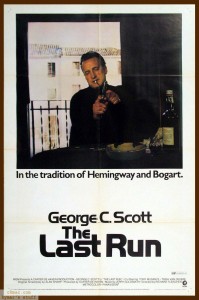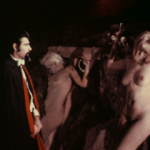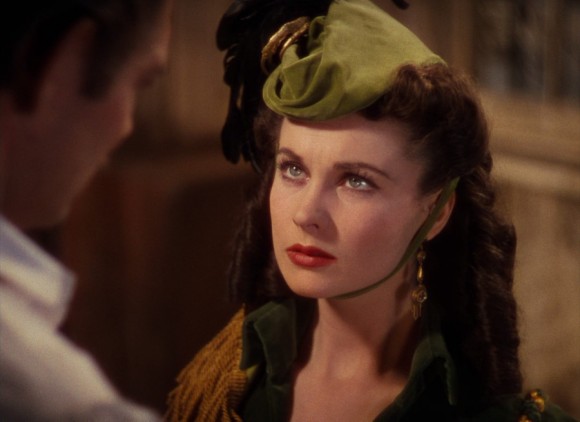![]()
The Internet has many uses, and foremost among these is providing multiple forums for people to register their flummoxed, spluttering indignence about one thing or another. Most of the outrage seems to involve changes in the Facebook layout, changes in the Facebook privacy settings, and embedded links with thumbnail .jpegs of one GOP Congressman or another. When the time comes to vent my own spleen, I generally try to confine myself to matters of which I know something about. These are limited to the State of the Arts, and to the state of the arts journalism which, in theory at least, drives the cultural dialogue.
Over the last week, much of the social media chatter among film folk has had to do with women, specifically with the role of women as drivers of that cultural dialogue. The testy Twitter badinage on that topic was interesting enough to make me want to make it the subject of this column—though, as a retrograde, Ralph Meeker-in-Kiss Me Deadly-esque knuckle-dragger, it seemed inappropriate to hold court on the subject by myself. As such, I’ve asked one of my very favorite working film critics—when prefixing “film critics,” of course, the word “working” is always relative—to visit and proffer her thoughts. This would be Violet Lucca of Film Comment, previously cited in this column for her insight into the feminist subtext of Delmer Daves’ Cowboy—informed, she later told me, by Norah Vincent’s Self-Made Man—and into Jerry Lewis’ sartorial commitment to character, or lack thereof. The column is hers to run wild with, though when the little dearie inevitably becomes nervous and tongue-tied in the face of the unaccustomed exposure on a stage of this size, I will step in to helpfully mansplain.
Violet: In the same week that Jerry Lewis confirmed that yes, he is still a misogynist, and rapist/Academy Award-winner Roman Polanski said that the leveling of the sexes was “idiotic,” a report by the Center for the Study of Women in Television and Film revealed that “top” male critics write 82% of the reviews that appear on Rotten Tomatoes. The critical community responded not with a series of rigorous self-criticisms in the Marxist-Leninst tradition, but instead with a few listicles about Female Film Critics You Should Be Paying Attention To. Whether Calum Marsh of Film.com or Jason Bailey of Flavorwire actively read the work of the women that they put their stamp of approval on, or if they simply alternated between Google and Rotten Tomatoes whilst looking for skirt for a few minutes, is not for me to speculate about. But does a pithy listicle a sexist make? Creating a “user’s guide” to female writers—their virtues summarized in roughly 50 words, in much the way you’d compose a list of printers you could possibly purchase—is an insincere and wrong-headed way of “solving” the problem. I defer to Kathleen Hanna’s RIOT GRRRL MANIFESTO: “BECAUSE we are interested in creating non-hierarchical ways of being AND making music, friends, and scenes based on communication + understanding, instead of competition + good/bad categorizations.”
![]()
Nick: What Calum-ny! (Ha. Ha.) Your barely-concealed jealousy at not being featured on that Flavorwire list is almost touching. Leaving Jerry aside for the moment—is it any great surprise that the author of The Ladies Man, whose oeuvre revolves around sexual insecurity and confusion, exhibits the same characteristics in life?—I’ll return to the news from the Center for the Study of Women in etc etc.
The most sensible reaction that I saw on the Twittersphere came from my friend Genevieve Yue: “Instead of presumed bias, I’d rather see corresponding compensation figures.” Genevieve’s recently completed her PhD in Critical Studies, and while I can’t speak to that particular department, I have certainly swum among possessors of XX chromosomes at gatherings of Art History PhD candidates. For whatever reason, such occupation-based gender disparities do exist. In the case of film criticism, something perverse in me asks if it isn’t indicative of the professional rise of women that they are less than ever represented in a line of work that isn’t exactly a growth industry—or indicative of why they aren’t flocking to cinephile culture itself. Using your “scene” analogy, the rep scene, with its proliferation of musky, menacing hobos and gynophobic nerds, might not exactly be a beacon for the creative-minded young woman looking for a space in which she can assert herself and make something cool happen. But, then, I am but a child in these matters.
Violet: I think you’ve really hit the nail on the head with the word “musk.” Even though I don’t like to make sweeping generalizations about either sex, it’s true that women don’t find the deathbed of film culture appealing, nor are they charmed by the clumsy, unwanted sexual attention and casual sexism of its insular pallbearers. Why would anyone choose to attend dinner parties filled with a roomful of poorly socialized rep fiends whose ideas about emotional verisimilitude and gender come almost exclusively from the male-dominated Hollywood dream factory? How could you possibly take their opinions seriously? Meanwhile the abovementioned study barely registered in non-film outlets. Even Jezebel, which solely runs “feminist think pieces” about Yahoo News stories and what dumbshit celebrities eat/say/wear, somehow tasked their (lone?) male writer with rewording the press release. It is, anyhow, worth noting that the gap in writers is slightly-less dire when taking into account print and radio outlets—i.e., older media staffed by older writers.
![]()
Nick: A film culture devolved into a circle jerk will, inevitably, be a barren film culture. Taking an uninitiated—that is to say, non-cinephilic—date to a MoMA screening is an experience only slightly less mortifying than the porno theater scene in Taxi Driver. I was talking the other day to Caroline Golum, a programmer and general NYC movie-scenester, about making the rep rounds as a solo woman. She said New York was at least better than her native LA for M-F ratios, and that best of all were the newer, off-the-grid screening spaces: Spectacle, Light Industry, etc. where a lady can find herself in the company of more than one other woman born after the Eisenhower administration. Again, there is the “scene” idea—I have a sense that the hip and inclusive film culture of the future will owe as much to the basement show as to the classic cinematheque. Maybe it’s like when the bully skinheads took over Washington DC hardcore in the mid-‘80s, and everyone who was invested in that scene as something other than a hermetically-sealed fraternity cut and ran to form a new scene of their own in the storied Revolution Summer of 1985? Maybe I am torturing this comparison to death?
Violet: Those who do not learn from the mistakes of the DC hardcore scene are doomed to repeat them. Right now, there is nothing being done (in New York at least) to slow the decay of film culture, microcinemas be damned. I’m reminded of the UnderWire/BFI competition that sought out previously unpublished female journalists to do original reporting on someone in the film industry. Though Miriam Bale (one of Marsh’s seven) derided it as a “contest to find the new Miss Sight and Sound”—perhaps more for the patronizing press release than the concept—I appreciated the effort to find new blood outside of the cronyism and interns-only mechanics of the current landscape, which is very much a step in the right direction. I doubt very much that editors of respected publications voluntarily sift through blogspot.com sites in search of the next hot young thing—the ones I know don’t.
Nick: At various points in my life as a critic I have been approached by editors who’ve asked me, in what I can only presume is earnestness, to recommend female critics. (I, of course, always decline, and nominate my bro pals instead.) When one adds to this something like that UnderWire/BFI contest—however tactless its press release may be—it’s hard to believe that there aren’t people out there with sincere intentions to remedy the bemoaned imbalance. Is the problem editorial chauvinism? Or is it that one cannot simply will into existence female film critics who write forcefully and with knowledge? I am of course kidding about the “who write forcefully and with knowledge” bit—we both know there’s no detectable correlation between this and the ability to regularly place material in paying publications. Maybe a little more indefatigable, indestructible egotism, regardless of talent, is in order? To paraphrase Gore Vidal, if you think you’re a good writer, you must tell people.
We seem generally to agree that the lack of well-placed female film critics is attributable to something endemic to film culture, to cinephilia in its present form—though to prove this thesis, comparative figures for critics in other media would be helpful. Apparently it wouldn’t take long to tabulate the art critics. What about music writers?
Speaking of which! As we’ve been swatting the shuttlecock back-and-forth for this column, word has arrived that Pitchforkmedia will be launching a new film reviews site in July, The Dissolve. (A rather death-of-cinema name, innit?) My first reaction to this news was smug self-congratulation at my own clairvoyance, for I’d made some comments, just over three months ago, in this little-traversed corner of the Internet, on the gradual Pitchforkification of film criticism. Whatever reservations I have about the cultural impact of Ryan Schreiber’s empire—and, really, I have almost nothing but—the announced roll-call of staffers and columnists to date includes some writers whom I personally like. By my count, there are exactly two women on the payroll. So one hopes the editorial staff of Keith Phipps, Scott Tobias, Tasha Robinson, and Genevieve Koski will use their opportunity to even the score, and clear the air of the steady drone of Halitosis-scented received opinion.
![]() Violet: The Vidal quote is apt, because women are statistically less likely to ask for raises or promotions—they wait for their superiors to recognize their achievements, and award them accordingly. I think this Lacanian difference is best explained by the Dove commercial parody wherein average-looking men describe themselves to sketch artists as possessing Brad Pitt-level handsomeness. But, as a man with whom I was in a painful, dragged-out long-distance relationship once cautioned me—sometimes life gets in the way. Aside from my ovaries and quaint Midwesterness, which bombard my brain with anti-boast messages, I also have a Day Job that sometimes requires me to think and/or learn new things, and will always require me to be at meetings and sacrifice, at a moment’s notice, a few nights and weekends to it. Obviously, overdraft fees and poor credit scores transcend gender, and remind of the larger reality that, yes, this is an industry with rapidly decreasing paid opportunities. Why the hell would anyone choose to go through so much, for so little, with such jerks? I also caution men to carry a rape whistle and a thick book to ward off Anthology Film Archive C.H.U.D.s. Guys get violated, too, Nick!
Violet: The Vidal quote is apt, because women are statistically less likely to ask for raises or promotions—they wait for their superiors to recognize their achievements, and award them accordingly. I think this Lacanian difference is best explained by the Dove commercial parody wherein average-looking men describe themselves to sketch artists as possessing Brad Pitt-level handsomeness. But, as a man with whom I was in a painful, dragged-out long-distance relationship once cautioned me—sometimes life gets in the way. Aside from my ovaries and quaint Midwesterness, which bombard my brain with anti-boast messages, I also have a Day Job that sometimes requires me to think and/or learn new things, and will always require me to be at meetings and sacrifice, at a moment’s notice, a few nights and weekends to it. Obviously, overdraft fees and poor credit scores transcend gender, and remind of the larger reality that, yes, this is an industry with rapidly decreasing paid opportunities. Why the hell would anyone choose to go through so much, for so little, with such jerks? I also caution men to carry a rape whistle and a thick book to ward off Anthology Film Archive C.H.U.D.s. Guys get violated, too, Nick!
As someone who has dipped her toe into several other industries, I can assure you that yes, jerks and low paying jobs are everywhere, but they seem to be proliferating in our line even as the twilight of film culture draws nigh. I never paid much attention to Pitchfork during its heyday, except when I vigorously disagreed with their reviews. (It’s worth noting that a woman authored this insensitive, artless review of The Fiery Furnaces’ Rehearsing My Choir that always jumps to my mind when thinking about the site.) Xeroxing Pitchfork is bad news for film culture because you can’t just half-listen to a leaked track while at work and determine whether or not you want to add the whole album on Spotify. Save grades for eggs and swots; they do not belong on movies. That’s certainly not a unique opinion—it was something Richard Corliss wrote in 1990 for Film Comment about “thumbs up film culture,” where he criticized the tendency for TV reviewers to be more performer than reviewer. Not surprisingly, the generation that grew up on those personalities embraced snarky prose over content. Even in their longer reviews, it seems as though the way that Pitchfork made a name for itself was encouraging writers to write as flamboyantly as possible. The tendency to use a sledgehammer instead of research to deal with a movie seems the norm now, even at quality outlets. But in the exasperating 24-hour cycle of reviewing—as evidenced by the poor souls who got up at 3am on Sunday to watch and then immediately pound out words on Arrested Development—who has the time? If it isn’t on the Internet, did it really happen?
Nick: In a Wall Street Journal piece that appeared alongside the announcement of The Dissolve, Pitchforkmedia president Chris Kaskie was quoted saying that, “No one is approaching film like Pitchfork approaches music.” If he means what I think that means, I’d have to say “Thank Christ, and ever may it be so!” However, if he means what I think he means—that there isn’t already a wealth of engaged, high-quality, online-specific film content out there—I’d have to say “Fuck you.” As noted in the article, though, Pitchfork “generates between $5 and $10 million a year in advertising revenue,” which means they’ve been able to monetize what I’ll broadly call arts journalism to a degree that no extant film site, not to speak of the remaining rock rags, has. Onward hip hegemony! And while underconfident would-be female critics continue to hem and haw while putting together their pitches, swaggering Pfork founder Ryan Schreiber today Tweets “It’s already the best film site on the web and it hasn’t even launched yet.” Slow down, buddy. So far you’ve got some smart hires and inevitably posh site design on your side; the rest is still your pooch to screw.
By the way, this week the newly-cleaned-up, no-more-kid’s-stuff newsmagazine Vice—whose house style, come to think on it, is every bit as idea-resistant and easily aped by interns as the jazzy backward-running patter of ‘20s “Timespeak” devised by Briton Hadden and Henry Luce—had their first Williamsburg screening in association with Martin Scorsese’s Film Foundation, a series founded so the kids could “get schooled on the great movies we skipped over on Netflix because their covers looked boring.” Oh, you scallawags haven’t lost a fraction of your devil-may-care youthful insouciance! So it looks like the moment that every programmer and critic has pined for, when “the kids” will come out to screenings, and moviegoing will become a sexy, in-vogue pastime again, may happen sooner than later. The only trouble being that it will be bankrolled by some of the worst people in the world.
![]()
Violet: I could’ve gotten a job at VBS back in 2009—an acquaintance from undergrad had secured himself a job and a pool of barely-legal interns, and offered me the opportunity to edit live shows in their converted Williamsburg bunker. His most recent paramour was a former plus-sized model (read: normal-sized woman), who, as he excitedly explained to me over tacos one evening, like, didn’t know anything about movies or culture because she’d been modeling since she was, like, 12. But this is not a column about My Troubles With Men, or at least My Troubles With Men and Film. I never followed up on this lead, even though being involved in production and post-production was the reason I stayed in New York after finishing graduate school, long past the point of it making economic or social sense to do so. There was something distressing about the idea that a magazine was essentially trying to be a media conglomerate for things that fell within the realm of my taste. (I guess a neater way of saying that would be “Hipster Time Warner,” but that term means nothing exactly because companies like Vice have successfully colonized contemporary youth culture.) Now Pitchfork is trying to be all things to all young consumers, making serious bank in their ability to brand themselves as “quality.”
Not unlike dating someone you feel mentally superior to but think has a hot ass, the Internet can provide you with a false sense of how well you’re doing. Aggregators like Metacritic and Rotten Tomatoes place mature criticism next to knee-jerk reactions—sort of like putting Manohla Dargis, a lead critic for The New York Times, alongside Lisa Schwarzbaum, former Entertainment Weekly scribe, on a list of groovy women film writers. By billing a site or screening series as the quality alternative for the unwashed masses while flattering (instead of challenging or dialoguing with) their ADHD tendencies, your automatically invite an audience of dilettantes.
And speaking of mansplaining: I think that’s what you’ve been doing with whatever the hell this mess is every week. You expect someone to actually read all 5,000 words of your rambling man bullshit? Ever hear of an economy of words? Maybe you could actually write about A MOVIE once in awhile, or practice ACTUAL FILM CRITICISM? (Like I hadn’t read that argument about movie violence a million times.) Stop fellating the ghost of Tynan and write something of substance! Besides, how could anyone hold him as an emulatable hero? Oh, Calcutta! is unwatchable public schoolboy drivel that could’ve been punched up by one of those mouth-breathing rep-creatures you seem so eager to dismiss.
Nick: Tynan? If Ken Tynan were here, he’d take a crop to your impertinent backside, Missy. Tynan, you’ll recall—or, more likely, not—was a collaborator and great admirer of the man whom you describe in your fizzling opening salvo as a “rapist/Academy Award-winner.” That sort of flip dismissal is the kind of thing that you self-described “feminists”—a term so ubiquitous as to have lost any meaning whatsoever—invariably fall back on when you need to distract from the fact that your gender hasn’t produced any artist of comparable stature. (Well, I’ll grant you that Kathryn Bigelow does literally tower over noble Roman.) And I never thought I’d live to see the day when a woman chided me about structure. What was it that Tom Wolfe said of your great essayist, Sontag? A prose style with “a handicapped parking sticker valid at Partisan Review”? Maybe more applicable is the next part, on “McLuhan’s line about indignation endowing the idiot with dignity.” And of course you would bring the only man your sort of woman can seem to stand, old mummified Marx, into it. And the stale air of red-brick Manchester in the 1840’s along with him! There is a specter haunting your responses here—the specter of barely cross-examined attitudes, with nothing to buttress them. Serves me right for inviting a guest columnist in who’s clearly ragging. Oh, and I hate the fucking Fiery Furnaces, while Petrusich is one of the best Pfork ever had.
![]()
Violet: Only a gentleman scholar of your caliber would seriously suggest my arguments were a direct result of my wearing red underwear. I’d say you’re the one suffering from a wandering uterus. (Which was, in fact, a fashionable diagnosis for men in Georgian England, where most of your shitty attitudes about gender seem to come from.) Just like the mad men who successfully diluted feminism’s message of gender equality into “only pushy, man-haters are feminists” and “guys are overgrown children, so you can’t expect them to help you with housework,” you have just enough command of rhetorical arguments to turn your insecurities into pathos for idiots. But far from being the Don Draper of the critical scene, you’re barely a Lane Pryce. Any 12 year-old can Google inspirational quotes by dead (or nearly dead) straight white guys—maybe you should start a Tumblr instead of sullying Sundance’s brand with your weird rants. (I think most of your points could’ve just as easily been made using animated gifs of a baby goat kicking another goat in the head with “When film critics blog” written in 16-point Helvetica font above it.) Since you seem dead-set on pursuing a course of enmity, I suppose I shouldn’t feed your trolling anymore. There’s neither gold nor glory in it. In closing, I’d like to say that:
1) women shouldn’t feel pressured to shave their pubic hair because it serves a sanitary puropose
2) any critic who doesn’t read Amy Taubin isn’t worth shit
3) cash rules everything around me, which is why Bleeker Bob’s awning is on sale for $100 on Craigslist.
![]() Nick Pinkerton is a regular contributor to Sight & Sound magazine and sundry other publications. He lives in Brooklyn, NY. Follow Nick on Twitter @NickPinkerton.
Nick Pinkerton is a regular contributor to Sight & Sound magazine and sundry other publications. He lives in Brooklyn, NY. Follow Nick on Twitter @NickPinkerton.
 Most of the reportage on the employee shedding by Voice Media Group has been accompanied by some variation on the caveat “Disclosure: I used to work there,” which goes to show how essential a coming-of-age ritual logging some time at the Voice has been for aspiring New York journos. A reflection on this very point was recently posted by Zach Baron, a fellow alum I met briefly at a Voice Christmas party in 2008 or 2009. (At the last Christmas party I attended, in ’12, I think I was one of a dozen people over 23.) The piece, understandably perhaps, achieves a distance that I have not yet been able to muster—Mr. Baron left the paper in 2011, and since has placed his byline regularly in high-profile papers and magazines. I know continuing to give a fuck must but horrible for my health, yet I can’t sign off on Baron’s philosophical “So it is, so it has been, so it always shall be” thesis, which discounts the fact that things really can be ruined irreparably, and that there are people who should be held accountable for doing the ruining. I return, as I often do, to a line from Decline and Fall, Otto Friedrich’s account of the last years of The Saturday Evening Post, which folded not long after the last gasp of the New-York Tribune, in 1969:
Most of the reportage on the employee shedding by Voice Media Group has been accompanied by some variation on the caveat “Disclosure: I used to work there,” which goes to show how essential a coming-of-age ritual logging some time at the Voice has been for aspiring New York journos. A reflection on this very point was recently posted by Zach Baron, a fellow alum I met briefly at a Voice Christmas party in 2008 or 2009. (At the last Christmas party I attended, in ’12, I think I was one of a dozen people over 23.) The piece, understandably perhaps, achieves a distance that I have not yet been able to muster—Mr. Baron left the paper in 2011, and since has placed his byline regularly in high-profile papers and magazines. I know continuing to give a fuck must but horrible for my health, yet I can’t sign off on Baron’s philosophical “So it is, so it has been, so it always shall be” thesis, which discounts the fact that things really can be ruined irreparably, and that there are people who should be held accountable for doing the ruining. I return, as I often do, to a line from Decline and Fall, Otto Friedrich’s account of the last years of The Saturday Evening Post, which folded not long after the last gasp of the New-York Tribune, in 1969: No, you dummy, it’s not a woman! I am talking, of course, about James Franco of VICE Magazine, a publication that has done so very much to further the blase, shrug n’ smirk, couldn’t-be-bothered voice in American letters, establishing itself as a tastemaking organ while never discernably taking a hard critical stance on anything other than, say, deciding to pimp the Billysburg coke-party vacuity of A.R.E. Weapons. Franco has to date filed reviews of both Gatsby and Leviathan. For the actor/director/producer/novelist/artist/celebrity chef Franco—whose “Look at my shee-it” monologue in Spring Breakers has been frequently compared to Gatsby’s home tour and display of beautiful shirts by people with a passion for pointing out the obvious—nothing is worth doing if it’s not worth doing sloppily and haphazardly. His latest critical effusion, not quite up to the standards of most Letterboxd prose, is a pretty piece of work in which the 35-year-old adjunct English professor at UCLA includes the observations “I’m the biggest Moby Dick fan ever,” “I mean, WTF? How? How did the film’s makers achieve this poetry?”, and “At some point, a huge crowd of Israeli women filed in and overpowered the Daft Punk emanating from my headphones.”
No, you dummy, it’s not a woman! I am talking, of course, about James Franco of VICE Magazine, a publication that has done so very much to further the blase, shrug n’ smirk, couldn’t-be-bothered voice in American letters, establishing itself as a tastemaking organ while never discernably taking a hard critical stance on anything other than, say, deciding to pimp the Billysburg coke-party vacuity of A.R.E. Weapons. Franco has to date filed reviews of both Gatsby and Leviathan. For the actor/director/producer/novelist/artist/celebrity chef Franco—whose “Look at my shee-it” monologue in Spring Breakers has been frequently compared to Gatsby’s home tour and display of beautiful shirts by people with a passion for pointing out the obvious—nothing is worth doing if it’s not worth doing sloppily and haphazardly. His latest critical effusion, not quite up to the standards of most Letterboxd prose, is a pretty piece of work in which the 35-year-old adjunct English professor at UCLA includes the observations “I’m the biggest Moby Dick fan ever,” “I mean, WTF? How? How did the film’s makers achieve this poetry?”, and “At some point, a huge crowd of Israeli women filed in and overpowered the Daft Punk emanating from my headphones.” Nick Pinkerton is a regular contributor to Sight & Sound magazine and sundry other publications. He lives in Brooklyn, NY. Follow Nick on Twitter @NickPinkerton.
Nick Pinkerton is a regular contributor to Sight & Sound magazine and sundry other publications. He lives in Brooklyn, NY. Follow Nick on Twitter @NickPinkerton.







 Violet: The Vidal quote is apt, because women are statistically less likely to ask for raises or promotions—they wait for their superiors to recognize their achievements, and award them accordingly. I think this Lacanian difference is best explained by the
Violet: The Vidal quote is apt, because women are statistically less likely to ask for raises or promotions—they wait for their superiors to recognize their achievements, and award them accordingly. I think this Lacanian difference is best explained by the 





























































